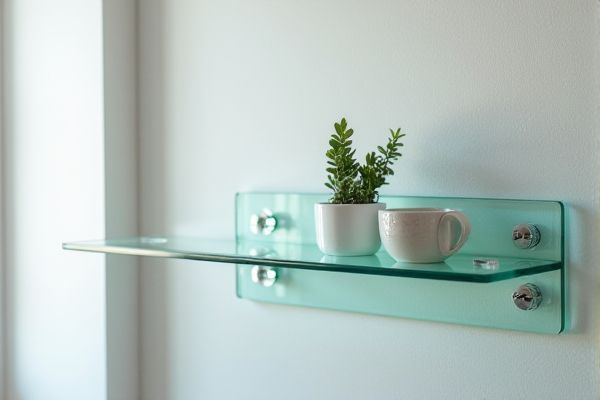
Glass shelves offer a sleek, modern look with greater weight capacity and scratch resistance, while acrylic shelves provide lightweight versatility, affordability, and enhanced safety due to their shatter-resistant properties. Discover which shelf type best suits your space and style preferences by exploring the detailed comparison ahead.
Table of Comparison
| Feature | Glass Shelf | Acrylic Shelf |
|---|---|---|
| Material | Tempered or standard glass | Poly(methyl methacrylate) (PMMA) |
| Weight | Heavier | Lightweight |
| Durability | High scratch resistance, brittle | Impact resistant, prone to scratches |
| Transparency | Crystal clear, no yellowing | Clear but may yellow over time |
| Load Capacity | Higher weight support | Moderate weight support |
| Maintenance | Easy to clean, smudge-prone | Easy to clean, avoid abrasive cleaners |
| Cost | Generally more expensive | More affordable |
| Safety | Can shatter, tempered glass safer | Does not shatter, flexible |
| Applications | Heavy-duty, elegant display | Light loads, decorative use |
Introduction: Glass Shelf vs Acrylic Shelf
Glass shelves offer superior clarity, durability, and a sleek appearance suitable for modern interiors, while acrylic shelves provide lightweight flexibility and enhanced impact resistance, making them ideal for versatile applications. Glass is more scratch-resistant and temperature tolerant, ensuring long-term maintenance-free use, whereas acrylic is easier to cut and install, allowing for customized shapes and sizes. Choosing between glass and acrylic shelves depends on balancing aesthetics, strength, safety, and installation requirements.
Material Composition and Properties
Glass shelves are composed of silica-based materials that offer high durability, scratch resistance, and a sleek, transparent appearance ideal for modern interiors. Acrylic shelves are made from polymethyl methacrylate (PMMA), providing lightweight, impact-resistant options with excellent clarity but lower scratch resistance compared to glass. The thermal and chemical stability of glass surpasses acrylic, making glass shelves more suitable for heavy-duty use and exposure to varying temperatures.
Aesthetic Appeal and Design Versatility
Glass shelves offer a sleek, modern aesthetic with high transparency that enhances light flow and creates an elegant, minimalist look in both residential and commercial interiors. Acrylic shelves provide greater design versatility due to their lightweight nature and availability in various colors and shapes, allowing for more creative and customized installations. While glass emphasizes sophistication and timeless style, acrylic shelves cater to vibrant, contemporary designs and practical applications with flexible form factors.
Durability and Strength Comparison
Glass shelves offer superior scratch resistance and a sleek, modern appearance, but they are more prone to shattering under heavy impact. Acrylic shelves provide greater impact resistance and flexibility, making them less likely to crack or break, though they can scratch more easily over time. Your choice depends on whether you prioritize the durability of shatter resistance or the strength against daily wear and tear.
Weight and Installation Considerations
Glass shelves are significantly heavier than acrylic shelves, requiring stronger wall anchors and more secure mounting hardware to ensure safe installation. Acrylic shelves are lightweight, making them easier and faster to install with standard brackets, ideal for DIY projects. Your choice depends on the wall type and the weight you plan to support, as heavier glass shelves demand professional installation and more robust supports.
Maintenance and Cleaning Requirements
Glass shelves require regular cleaning with non-abrasive glass cleaners to maintain their clarity and prevent streaks, and they resist scratches better than acrylic. Acrylic shelves need frequent dusting and gentle cleaning with mild soap and water to avoid surface damage and cloudiness caused by harsh chemicals or abrasive materials. Both materials resist dust accumulation, but glass offers easier maintenance for long-term clarity and durability.
Safety and Impact Resistance
Glass shelves offer a sleek, modern appearance but are more prone to shattering upon impact, posing safety risks. Acrylic shelves provide superior impact resistance and flexibility, reducing the chance of breakage and making them a safer choice for environments with children or high traffic. Your decision should weigh the balance between aesthetic preference and the importance of durability and safety.
Cost and Value Analysis
Glass shelves typically cost more upfront due to higher material and manufacturing expenses but offer superior durability and a premium aesthetic, increasing long-term value. Acrylic shelves are more budget-friendly and lightweight, making them suitable for short-term or flexible installations despite being less resistant to scratches and discoloration. Your choice depends on balancing initial investment against desired longevity and visual appeal to maximize cost-effectiveness.
Ideal Applications and Use Cases
Glass shelves excel in weight-bearing applications such as displaying heavy decorative items or electronics, thanks to their durability and rigidity. Acrylic shelves are ideal for environments requiring impact resistance and safety, such as children's rooms or high-traffic retail displays, due to their shatterproof nature and lightweight design. Both materials serve well in modern home decor, but glass is preferred for elegance and clarity, while acrylic is favored for versatility and safety.
Final Verdict: Choosing the Right Shelf
Glass shelves offer superior durability, a sleek modern look, and higher resistance to scratches and stains, making them ideal for long-term use in elegant settings. Acrylic shelves provide lightweight versatility, easier installation, and increased safety due to shatter resistance, perfect for casual or child-friendly environments. Your choice should balance aesthetic preferences, functional needs, and budget to select the shelf that best complements your space and usage.
 homyna.com
homyna.com